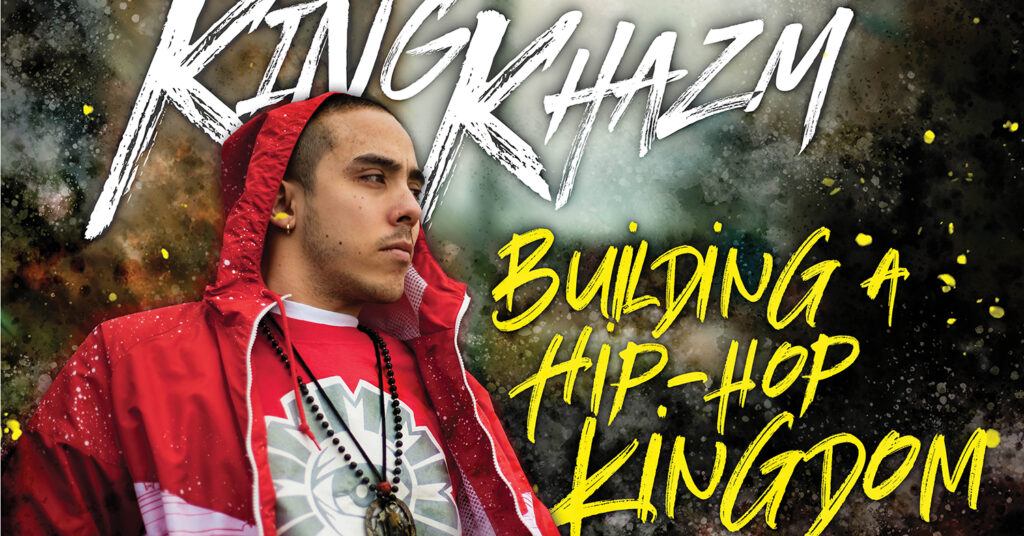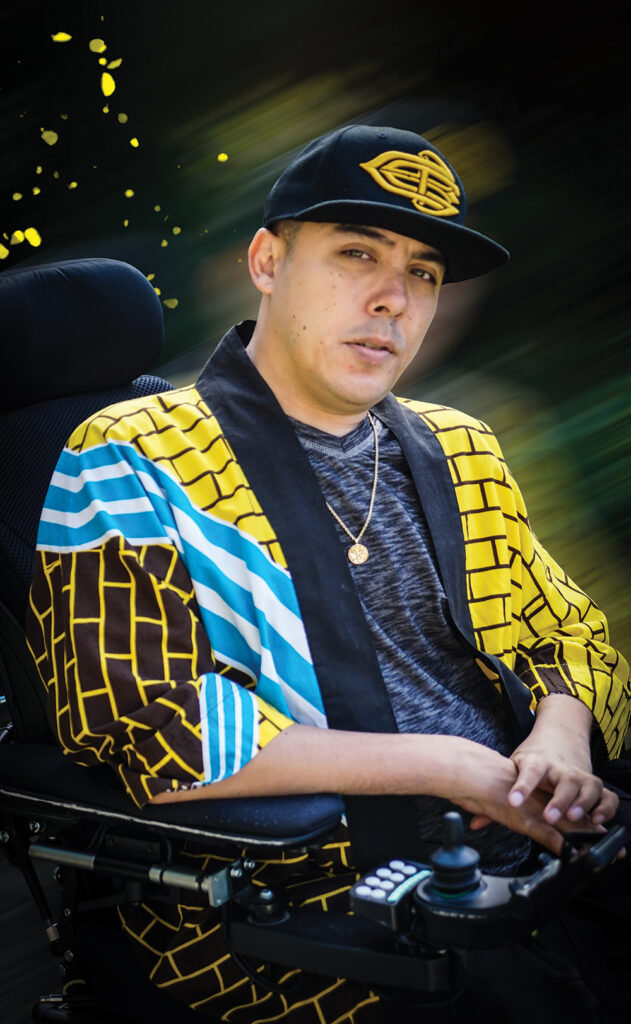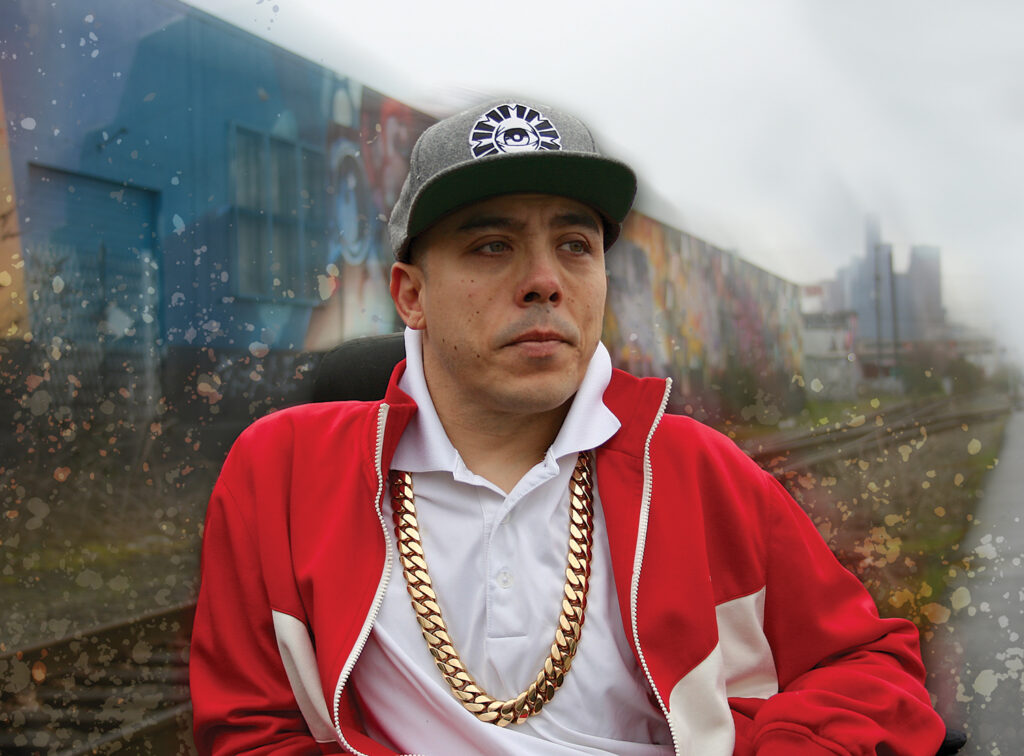Additional reporting by Alex Ghenis

As an emerging hip-hop and graffiti artist in Seattle’s Beacon Hill neighborhood in the ’90s, teenaged Daniel Kogita decided he would go by the name Khazm. Like a chasm, he wanted to break ground and saw himself as part of a vibrant underground community waiting to be exposed. He changed the spelling because “K” and “Z” flowed better in his art, and by the time he graduated high school everyone knew him as Khazm 247.
He lived up to his new moniker by dedicating the next decade to growing Seattle’s hip-hop community and making an international name for himself as a talented emcee, producer and visual artist. In 2005, the Universal Zulu Nation, one of the most famous and influential international hip-hop awareness groups, recognized his service by proclaiming him a Zulu King, a title the group used to recognize leaders. Thus, was born King Khazm.
Khazm hasn’t let the title or respect go to his head. He is still committed to empowering the underground and hip-hop communities, and as a proud wheelchair user, he has expanded his influence to do the same for people with disabilities and other underserved communities. Still, the soft-spoken king thinks about the future with the same passion and restlessness that inspired his name years ago.
“I’m one of the very lucky ones,” he says. “Sometimes I feel like I’m moving in slow motion because I live so much in the future. I think in great detail about where we should be going, where we are and what we can be. This feels so slow, like everything is moving so slow, but I have to remind myself that progress is indeed being made. We have to keep chipping away and count our blessings that we’re still here and able to see the progress over the years.”

Khazm describes his visual art as, “highly stylized, Salvador Dali-inspired, life-inspired. I like forced perspectives. I like sharp angles. I like exaggerated perspectives. My style is very introspective. Maybe something that’s a little bit more subjective, to just have to sit with it as heavy detail. I have a lot of different styles, but what I gravitate toward is more detail-oriented.”
From the Streets to the Spotlight
Despite just returning from a world tour and often being on the road, King Khazm’s home and true domain will always be Seattle and the 206-area code that it covers. He grew up on the city’s south end in one of the country’s most diverse zip codes. Paralyzed in a car accident at the age of 5 and growing up as a C7 quadriplegic in a rough neighborhood wasn’t easy, but Khazm found refuge in hip-hop and art. “I didn’t get into too much trouble,” he says. “I made a lot of mistakes, but nothing too serious.”
While he had a good family and upbringing, without any real mentors in the hip-hop community, he needed to figure things out on his own. As he did, his talent and charisma drew his peers closer and he emerged as the thing he never had, a mentor, or as he calls it, “a big homie.”
“People just kind of gravitated toward me,” he says. “I’d always be surrounded by people, anytime day or night, whether roaming the streets, initially as a graffiti artist, or getting into music and sharing my knowledge of beat-making and production with my peers or honing my skills with lyrics and showing them how to record.”
In 1995, the year before he graduated from high school, he and a group of friends founded the Madness After Dark Krew, a graffiti and hip-hop group. The MAD Krew organized events ranging from music and hip-hop shows to DJ battles to breakdancing competitions, all with the goal of invigorating Seattle’s underground scene.
For the next five years, Khazm and MAD Krew built their reputation and repertoire. Khazm and other members hosted a weekly TV show, Hip-Hop 101, featuring emerging artists from around the country. Broadcast on Seattle Community Access Network, Hip-Hop 101 aired weekly through 2009. Kitty Wu cohosted another music show on the network and quickly identified Khazm as a potential collaborator and friend. “He has this grandiose thinking about all things,” she says. “He’s a visual artist, he produces music, he’s a teacher, an educator, an activist … there’s really nothing he cannot do.”
Working with the MAD Krew, Khazm served as the creative director of Enter the Madness, an hour-long documentary featuring a montage of graffiti, other visual art, DJ battles, breakdance competitions, hip-hop shows and more. He joined some of the MAD Krew to form the group Cyphalliance (“cypher” in the hip-hop world is a ritual of coming together in a circle) and helped found Fresh Chopped Beats/MADK Productions as a record label to put out the group’s debut album. “That’s kind of where we started doing more regional and national tours and events and eventually international tours, and started making a name for ourselves,” he says.
In 2004, Khazm and Wu started 206 Zulu, a Seattle chapter of the international hip-hop Zulu Nation. The chapter was an evolution of all the work Khazm had done and a means to achieving his vision for the city’s hip-hop community. “He was such a great person to have as the lead,” Wu says, “because he was able to connect all of these varying groups [across Seattle]. He was able to just bring all of us together under the banner of 206 and got us to just start dreaming big and deciding what it is we wanted to do in the city.”
Today, functioning as a nonprofit, 206 Zulu offers all kinds of events and programs centered around hip-hop culture, including breakdance competitions, spray painting mural festivals, after-school programs, media creation opportunities and much more. “We pretty much go anywhere we can spread positivity,” says Khazm.
If there is a physical heart for 206 Zulu, it is unquestionably Seattle’s historic Washington Hall. Opened in 1908, the red brick building has a rich history but was facing demolition when a coalition including 206 Zulu purchased the property and launched a multi-million-dollar renovation effort.
The fundraising and actual renovation took over seven years, but 206 Zulu set up and helped keep Washington Hall busy with shows and events in the interim. During the renovation, 206 Zulu staff and community members would grab the corners of Khazm’s manual chair and guide him up the stairway to the venue.
The remodel finally finished in 2016, and 206 Zulu was named one of the three anchor tenants. The years of work restored the building’s Victorian charm and added an elevator and accessible bathrooms. “I’m sure my friends are glad they don’t have to pull me up the stairs every single time,” says Khazm.

As a C6-7 quadriplegic, Khazm has some function in his fingers but not enough to easily use a spray can, so he focuses on other mediums, including markers, stickers, brush paintings, canvas, wood boards, digital and other mediums: “I started as a visual artist, illustrator, graffiti artist, as early as I could hold a pencil. For large-scale pieces I mainly design them and have folks execute it. Everything is a learning process.”
The King Never Rests
Khazm played an integral role in finding a home for Seattle’s hip-hop community and fostering almost 30 years of growth in that group. You might think he would be content to sit back and enjoy his past success, but he is not that type of king. After a pandemic-forced pause, he hit the road last year to promote Pangea: Hip Hop Heals, an album on the impact of COVID, featuring 50 international collaborators from 17 countries. That tour took him to the United Arab Emirates and France.
He is currently gearing up to hit the road again to promote his newest album, Return of a MAD. Khazm describes the new album, released on Feb. 25, as “a little less introspective” return to the themes he covered on his last album, including the intersections of hip-hop, identity, disability and growing up biracial (he is half-Japanese).
In addition to advocating for Seattle’s hip-hop community, Khazm has gradually gotten more involved with the disability community. He released a single called “disAbility” in honor of the 25th anniversary of the ADA and performed the song live as part of Seattle’s celebration. He has never hesitated to show his wheelchair in his music videos or on camera, but some of his recent lyrics delve into his thoughts on disability more than his older music.
In 2018, he joined Seattle’s Commission on Disability and the board of the Here and Now Project, the Washington chapter of United Spinal Association. “He’s got a lot of wisdom that comes with living with a disability for so long,” says Kenny Salvini, the Here and Now Project’s founder. “He is super introspective and thoughtful — exactly the kind of person you want to grow and develop an organization.”
When he reflects on how far he has come since he was a kid rolling around Beacon Hill, Khazm always thinks back to the role hip-hop played in guiding him. “Hip-hop and the arts were a real grounding point for me,” he says. “Hip-hop kept me alive through the darkest of times. … It literally saved my life.”
Sitting in a Paris hotel room while on tour, Khazm exudes a sense of the surreal as he reflects on the last 30 years. “I’ve never really had a traditional kind of job,” he says. “I don’t even know if I could survive in that world.”
Surreal as that may feel, the impact he has had on the Seattle hip-hop scene is very real. Thanks to the efforts of 206 Zulu and other organizations, aspiring artists have numerous options, including hip-hop residencies and access to recording studios. He says it was hard to get the type of money for that access back in the day, “but now we’ve got free access for youth and all kinds of stuff and all you have to do is just have a desire to get in there.”
Years ago, he set out to bring the underground hip-hop culture to the surface. Today it can be hard to look around without seeing its influence, yet Khazm’s pride is tempered.
“It’s a double-edged sword,” he says. “It’s great to see the expansion of hip-hop. I just want to instill the cultural aspect of it — that it is bigger than just a genre. It’s the dance, the music, the art, the traditions, the principles, the history and all these different aspects that make hip-hop culture.” Now that hip-hop is fully in the mainstream, Khazm sees too many artists sacrificing the cultural focus for financial returns. “It’s positive that they can get out of the hood to rap or whatever, but hopefully there’s some sort of connection to the culture and how they arrived at what they’re doing.”
As a C6-7 quadriplegic, Khazm has some function in his fingers but not enough to easily use a spray can, so he focuses on other mediums, including markers, stickers, brush paintings, canvas, wood boards, digital and other mediums: “I started as a visual artist, illustrator, graffiti artist, as early as I could hold a pencil. For large-scale pieces I mainly design them and have folks execute it. Everything is a learning process.”
Khazm describes his visual art as, “highly stylized, Salvador Dali-inspired, life-inspired. I like forced perspectives. I like sharp angles. I like exaggerated perspectives. My style is very introspective. Maybe something that’s a little bit more subjective, to just have to sit with it as heavy detail. I have a lot of different styles, but what I gravitate toward is more detail-oriented.”
Support New MobilityWait! Before you wander off to other parts of the internet, please consider supporting New Mobility. For more than three decades, New Mobility has published groundbreaking content for active wheelchair users. We share practical advice from wheelchair users across the country, review life-changing technology and demand equity in healthcare, travel and all facets of life. But none of this is cheap, easy or profitable. Your support helps us give wheelchair users the resources to build a fulfilling life. |


Recent Comments
DINOS PITSILLIDES on Functional Fitness: How To Make Your Transfers Easier
Stosh on Functional Fitness: How To Make Your Transfers Easier
Bill on LapStacker Relaunches Wheelchair Carrying System